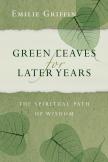Life Begins at 80
What is a person—in this case, the author—to do when she has reached the age of 75 but is informed by her doctor that she may live another 15 years or longer? She may have completed the biblical life span, but faces the prospect of additional years to be lived out in pain and with the vivid awareness of declining powers and growing challenges. In this modern age of improved medication and lengthening life expectancy, she has plenty of company. Erik Erikson, who had famously defined the seven ages of life, realized well before his death that he had outlived his own categories. Erikson, the author tells us, took up the challenge by writing and speaking about these later years as “new and adventurous territory.”
Emilie Griffin, a prolific author of books on Christian spirituality, has followed Erikson’s lead in this latest volume. Griffin, who has been suffering from painful rheumatoid arthritis for years, acknowledges the need to recalibrate our understanding of aging. Even so, she admits that she’s not so much plumbing the problems of old age, even less seeking an answer to the mystery of decline and death, as asking “how Christian faith informs life’s journey, especially in the later years.” Her own experience, together with that of all the others she draws on in this short volume, witnesses to the possibility that what is so boldly proclaimed in Jeremiah 17 might be true: “The righteous person is like a tree planted by living water, whose leaves stay green.” Yes, leaves can remain green, even in advanced years, the author declares.
There’s plenty of evidence to the contrary, Griffin knows. Old age brings infirmity, the loss of those powers on which we have relied for years, as well as an overall decline in health. But the steady advance of pain in the joints and everywhere else is only the half of it; even worse at times is the loss of friends to the ravages of death. This, of course, raises the fearful question the aged are forced to confront at every funeral they attend, “Can I be far behind?”
Loss and diminishment, then, would seem to be the hallmarks of old age. The best we can hope for is to surrender graciously what we have once enjoyed.
Or is it? There must be something to be gained as old age robs us of our eyesight, our bodily strength and the self-esteem and those other parts of our psyche that depend on this. The conventional answers, as advanced in Cicero’s tract on old age (“De Senectute”) and other ancient texts, are detachment, freedom from meretricious desires and wisdom. To this traditional argument the author adds the results of a British psychology professor’s recent research, cited in The New York Times, indicating that “we can expect to be happier in our early 80s than we were in our 20s.”
In the end, though, the author is not arguing that the blessings of old age more than offset the drawbacks, even if some of her sources suggest as much. The titles of her chapters—”Pushing Past the Pain,” “Grief, Loss and Anger,” and “Resetting Goals and Picking Up the Pieces”—point to a less euphoric outlook. Age is a precursor of death, and the latter has never had much to recommend it. She’s just offering us wisdom on how to survive and flourish in a period that smells of decline.
Throughout the book she summons a host of witnesses that point the way. The famed artists Renoir and Matisse, both of whom suffered from the same debilitating rheumatoid arthritis as the author, continued their pursuit of beauty despite the affliction that deformed their hands. Peter Drucker, the founder of modern management theory, retained his child-like fascination with life to the very end of his own. Nelson Mandela, Billy Graham and his wife Ruth, and two cardinals of the church, John Henry Newman and Avery Dulles, did much more than battle old age to a draw. Distilling the experience of the many decades they had lived, they made significant contributions to the world in their later years.
Griffin’s book, then, does not offer a grand argument on aging and holiness. The volume, like life itself, is a pastiche of experiences, some good and some bad, but all sustained by faith and good humor. Each chapter is more an exhortatory homily than an essay, each packed with real life examples, each followed by questions to stimulate reflection and a prayer.
At bottom, the defining feature of old age is a gradual surrender of our human powers that prepares us and summons us to the final surrender of life itself. Spiritual growth can occur during this time of diminishment and loss, of course, but only on condition that we have the resources to make the best of a difficult time. The author’s counsel here may help us detect some of the hidden graces of old age, but for the most part it merely offers us guidance on how to keep those leaves fresh and green. We are not called to roll back the ravages of age, but to keep walking, as Abraham and Sarah did, until the very end of our life’s journey.
This article also appeared in print, under the headline “Life Begins at 80,” in the February 4, 2013, issue.








